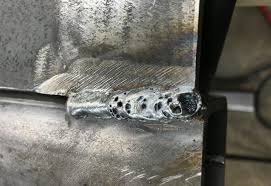What is Porosity in Welding: Important Tips for Achieving Flawless Welds
What is Porosity in Welding: Important Tips for Achieving Flawless Welds
Blog Article
Understanding Porosity in Welding: Discovering Reasons, Effects, and Prevention Methods
As professionals in the welding market are well conscious, understanding the reasons, effects, and avoidance methods related to porosity is vital for accomplishing durable and dependable welds. By diving into the origin causes of porosity, examining its damaging results on weld quality, and exploring reliable avoidance methods, welders can improve their expertise and skills to generate premium welds continually.
Common Reasons of Porosity
Contamination, in the form of dust, grease, or corrosion on the welding surface, produces gas pockets when heated, leading to porosity in the weld. Improper securing occurs when the securing gas, commonly utilized in procedures like MIG and TIG welding, is unable to totally safeguard the liquified weld swimming pool from reacting with the surrounding air, resulting in gas entrapment and succeeding porosity. Additionally, poor gas insurance coverage, typically due to incorrect flow prices or nozzle positioning, can leave parts of the weld unguarded, permitting porosity to form.
Results on Weld High Quality
The presence of porosity in a weld can considerably compromise the total top quality and integrity of the welded joint. Porosity within a weld creates gaps or dental caries that compromise the framework, making it a lot more vulnerable to breaking, corrosion, and mechanical failing.
Furthermore, porosity can hinder the effectiveness of non-destructive screening (NDT) methods, making it challenging to spot various other problems or stoppages within the weld. This can result in considerable safety issues, specifically in important applications where the structural integrity of the bonded elements is extremely important.

Prevention Techniques Review
Offered the destructive impact of porosity on weld quality, effective avoidance methods are essential to preserving the architectural integrity of bonded joints. One of the primary avoidance methods is detailed cleansing of the base products before welding. Impurities such as oil, grease, rust, and wetness can add to porosity, so making certain a clean job surface is essential. Correct storage of welding consumables in completely dry conditions is additionally vital to avoid wetness absorption, which can bring about gas entrapment throughout welding. In addition, selecting the appropriate welding criteria, such as voltage, current, and take a trip rate, can assist decrease the danger of porosity formation. Making certain adequate protecting gas circulation and protection is another important prevention method, as insufficient gas protection can cause atmospheric contamination and porosity. Proper welder training and accreditation are crucial for executing precautionary actions successfully and consistently. By integrating these prevention methods into welding methods, the incident of porosity can be significantly lowered, causing stronger and extra trusted welded joints.
Importance of Proper Shielding
Correct protecting in welding plays an essential role in stopping atmospheric contamination and guaranteeing the integrity of bonded joints. Protecting gases, such as argon, helium, or a mix of both, are typically utilized to protect the weld swimming pool from responding with elements airborne like oxygen and nitrogen. When these reactive aspects enter call with the hot weld pool, they can create porosity, causing weak welds with decreased mechanical buildings.

Insufficient securing can lead to numerous defects like porosity, spatter, and oxidation, jeopardizing the structural integrity of the welded joint. Therefore, sticking to proper protecting practices is important to create premium welds with minimal problems and make certain the longevity and integrity of the bonded elements (What is Porosity).
Surveillance and Control Approaches
How can welders successfully check and control the welding procedure to ensure optimum results and avoid flaws like porosity? One trick technique is through using innovative monitoring technologies. These can include real-time monitoring systems that supply feedback on parameters such my link as voltage, sites current, travel speed, and gas circulation rates. By continuously keeping an eye on these variables, welders can recognize inconsistencies from the ideal conditions and make immediate modifications to stop porosity development.

Furthermore, carrying out appropriate training programs for welders is important for keeping track of and controlling the welding procedure successfully. What is Porosity. Enlightening welders on the value of maintaining consistent criteria, such as appropriate gas shielding and travel rate, can aid avoid porosity issues. Normal evaluations and certifications can also ensure that welders are proficient in monitoring and regulating welding processes
Moreover, the use of automated welding systems can enhance monitoring and control capacities. These systems can specifically manage welding criteria, decreasing the possibility of human error and making sure consistent weld quality. By integrating advanced tracking technologies, training programs, and automated systems, welders can successfully monitor and control the welding procedure to minimize porosity flaws and achieve high-grade welds.
Conclusion

Report this page